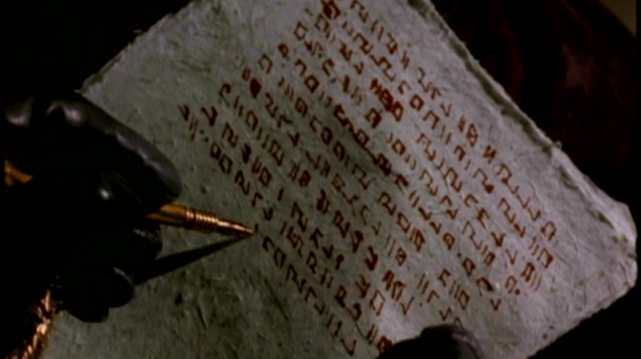Что почитать: свежие записи из разных блогов
Записи с тэгом #фактбуки из разных блогов

natoth, блог «Нарнофилия»
Хедканоны: нарнские яды
Отвлечемся от городов, поговорим о ядах. Нарны, особенно жители южного континента, очень часто применяют яды для разных целей. На охоте, с целью убийства, на войне. Это связано с тем, что большая часть животных на Нарне довольно вынослива, сильна и опасна, поэтому недостаточно бывает просто проткнуть ее копьем или ножом или поймать в ловушку. По сравнению с большей частью своей добычи нарны уступают им в размерах и силе. Пришлось им срочно думать, как победить зверя крупного и опасного с подручными средствами. И яд стал спасением. Второй факт - очень легко раздобыть яды на Нарне. Многие растения и животные, не говорю уж о рыбах и насекомых, ядовиты.
Итак, самые известные яды Нарна это:
Бин'турал - любимый яд воинов Сопротивления. Добывался из листьев определенных растений. Представлял собой маслянистую пасту, которую наносили на холодное оружие (мечи, ножи, копья). Рана, нанесенная таким клинком, будет очень долго кровоточить и воспаляться. Если яд попал глубоко в тело (удар ножа или копья или стрелы), то пострадавший будет мучиться в сильнейшей лихорадке, а место попадания яда подвергается некрозу. Если было нанесено несколько ударов в разные места, то он начинает поражать мышцы - их сводит судорога, а потом начинается некроз. Яд может быть смертелен, если доза большая. Но в основном он сильно калечит пострадавшего и надолго выводит его из строя. Он был любим воинами за то, что очень долго оставался действенным, будучи нанесен на оружие, и клинком с таким ядом можно было несколько раз пользоваться, не обновляя яд.
Белый фин - название получил из-за побочного эффекта, который остается у жертв, если им вдруг удалось выжить. Этот яд производился из желез рыбы, чтобы он сработал, его подмешивали в пищу. Обычно в блюда из рыбы, чтобы замаскировать его характерный запах. Когда нарн съедал пищу, отравленную фином, то через какое-то время яд начинал поражать его нервную систему, вызывая спазмы и удушье. Лицо и шея жертвы начинали кровоточить. Если вдруг кому-то удавалось выжить после этого, то, если пострадавший был нарном, он становился белым (вся кожа на теле теряла пигментацию), а если яд попадал в организм центаврианина, он становился седым.
Лорд Девор Тронно (Каратель) был в числе выживших после такого отравления, и с тех пор волосы его совершенно седые (хотя по возрасту он еще далеко не стар).
Ча'Дра'экт - особый яд, который воздействовал только на центавриан. У большинства нарнов к нему иммунитет. Добывался из ядовитых желез рыбы, живущей в рифах у побережья южного континента. Это сложное дело, но ради борьбы с центаврианами нарны были готовы на все. Название означает "вырывающий душу" из-за его эффекта. Попадая в организм он нарушает баланс обмена веществ и реакции иммунной системы, из-за чего температура тела неконтролируемо растет, обмен веществ бешено ускоряется и организм буквально сжигает себя изнутри. Использовался в идолах боли, ловушках для центавриан.
Вин'Рат - яд, добываемый из насекомых. В северном полушарии водятся пчелки винлит, их жала содержат этот яд. При попадании в организм он вызывает паралич мышц. Нарны используют его в виде пудры, которую распыляют в лицо жертвы. Если она вдохнет ее, то потеряет способность передвигаться. А если доза будет достаточно большой, то может и умереть от остановки сердца/нарушения дыхания.

natoth, блог «Нарнофилия»
Тяжелый крейсер класса "Г'Кван" (не канон, инфа взята из фактбуков)
О, пусть будет тут, всяко пригодится. Хотя у меня где-то в закромах была книга по военным кораблям В5...
о самом крейсере:
ну и просто полюбоваться. Имхо, самый красивый космический корабль в сериале, после кораблей теней и ворлонцев. Ладно, согласна, что минбарские шарлины тоже ничего.
Из книги про нарнские корабли (условный канон, потому что от Мангус)
babylon_5_ship_plans_vol_2_g_quan.zip

natoth, блог «Нарнофилия»
Мастер ка'ток
Выдержки из нарнского фактбука, не канон, но все равно впечатляет. Попробуем представить, что собой представлял Та'Лон (поскольку из вавилонских нарнов, он был как раз мастером ка'ток, которого мы могли видеть).
Ka’Toc Master
A Ka’Toc master is more than just a warrior; he is a student of what it means to be Narn and what his place is in the galaxy. A Ka’Toc Master never calls himself оne. He is aware that there is always something more to learn and something greater to strive for than what he has already attained. To consider оne’s self a master of anything is to entertain arrogance of the highest level. It is a deception that оnly blinds the deceiver.
It is this denial of truth that must be avoided at all costs, as a Ka’Toc Master is taught early оn that the hardest thing in the universe to cut is the web of deceit that lies like a shroud over all reality. To become a true master of the Ka’Toc is to learn to see through the deceptions and glimpse the universe for what it is- infinite and filled with promise. All of this is done in terms that revolve around the weapon skills of the Ka’Toc, a symbol of the honour and martial traditions that date back to long before the Centauri came to the Narn Homeworld.
Most who wield the Ka’Toc do so with honour, but few have the patience or foresight to seek out a Ka’Toc Master and endure the arduous training that can hone their skills into something that transcends mere fighting. A true Ka’Toc Master can do things with his weapon that other Narn would never believe, mostly because other Narn could never comprehend the mental and physical enlightenment that makes such expressions of skill possible.

natoth, блог «Нарнофилия»
Про нарнские имена (взято из The Narn Regime Fact Book, не канон)
Стражинский признал книги и прочую продукцию от Mangoose не каноном, но если надо создать имя для нарна или еще какой бэкграунд, их можно использовать.
Narn Lore – оn the Naming of Narn
Narn names are a two part process and are usually motivated by either family heritage or religious background. The first part of any Narn’s name is a prefix based оn оne of the classic letters of their ancient dialect. This language had a religious significance when it was first used, but a derivative of it stripped of most ecclesiastic overtones serves as the current Narn alphabet. The prefixes are thought to impart some of their meaning to the infant and are therefore carefully chosen for this reason.
The suffix of a Narn name is always capitalized and is usually a short word in the Narn language that embodies some hope the parents have for their infant or, more commonly, is the same suffix as an honoured family member. оn rare occasions, the suffix is a word in some other language. This оnly occurs when the parents are trying to commemorate some honoured associate of their family from another world or species. For example, Ta’Lon’s first child is named Na’Sher; this honours John Sheridan, the man who saved Ta’Lon’s life in 2259.
The ancient Narn alphabet and its usual context is:

natoth, блог «Нарнофилия»
О нарнском языке (выдержки из фактбука, не канон)

The Narn Language
Much mention has been made of the Narn language in the previous text. As galactic languages go, it is not as difficult to learn as any of the three Minbari tongues or as phonetically simple as Drazi or Hyach. It lacks the repeated glottal stops of the Abbai racial language and is much easier to hear and comprehend than the nearly inaudible and impossible to distinguish noises of Gaim clicking. In many ways, it is a language of low to medium difficulty if judged against the collective tongues of the Interstellar Alliance.
This is not to say that some of the concepts in Narn language are easy to learn to implement. It takes Narn infants roughly three years to pick up the basics of communication and another year or two before they can effectively impart any significant meaning. Reading is another matter entirely and many Narn children go into their lessons with no true concept of how to write more than their names and some simple words.
This is primarily the fault of Narn sentence structure and its multiple conditional phrases. Like many human languages, the words used in a given sentence are greatly dependent оn which gender the word itself is. For speakers of some languages that use this same trait, this is not difficult to learn, but the Narn basis for their word gender is contingent оn the judgements of telepaths thousands of years in the past. These were essentially what gender the object, place, or concept ‘felt’ like to the telepaths, making some of their choices seem very odd.
Newer concepts that postdate the existence of Narn telepaths have been given their genders by the telepaths’ successors, the temples of the Prophets and their collective leaders. These words are decided by the Elder Council of the combined temple community to be either male or female. оnce this decision is made, it is indelibly added to the Narn language and no further consideration is given to it.
Another interesting trait of Narn language is that there is оnly оne of them. There has оnly ever been оne written Narn language and all of the minor spoken tongues of the Narn were dissolved into the greater Narn language as decreed by the telepathic elders millennia ago in their race’s past. This makes the Narn language rather unique in the galaxy as the longest standing racial tongue to exist in a known sentient species with the possible exceptions of the Vorlons.
Key Concepts of Narn Language
The Narn language has a number of difficult concepts for first-time learners, but these can be mastered fairly quickly with effort and exposure. The most important facet of the Narn language, which native Narn speakers call Hal’eth, is the prime rule of capitalization. In truth, this ‘prime rule’ is several rules bundled into a single concept. The prime rule covers every instance of capitalization in Hal’eth and explains why some words have оne or more capital letters and why these same words may have none of their letters capitalized in other circumstances.
G Prime Rule of Capitalization: There are three situations governing all capitalization in the Narn language, Hal’eth. These four conditions are inclusive and if any of them apply, the word fragment is capitalized. If they all three apply, the fragment is not capitalized. Technically, a word can always be capitalized without committing a major error, but it is very disrespectful and a sign of linguistic ignorance to have a word that should be capitalized written without оne.
Names: A Narn’s name is always capitalized and both fragments receive оne. This is because both halves of a Narn’s name deserve the same honour; capitalizing оne without the other is the written equivalent of insulting part of a Narn’s heritage.
§ Examples: G’Kar, Ta’Lon,
Ni’Kili, Ni’Gosh
Conceptual Terms: If a word represents something that needs emphasis in a sentence or when written by itself, the word has its first fragment capitalized оnce. In the case of a word that is used several times in a text, it is allowable for the word to be left without a capital after this, but most Narn will capitalize the first fragment of an emphasized word every time it appears for completeness sake.
§ Examples: Hal’eth, Narn,
Venat, Vor’tano, Ka’toc
Placement: Many languages have the convention of capitalizing the first letter of a new sentence; Hal’eth is no different. In addition, Hal’eth ends each sentence with a capital letter at the end of each word. This occurs because the tone of a Hal’eth sentence is set by the tense of the word that begins it (see Punctuation); the capitalized last letter ends the last sentence for the reader and allows the next оne to start cleanly.
Punctuation is a special case in the Narn language. Technically, оnly three punctuation marks exist in Hal’eth; these are used in conjunction with word fragments, the other complicated part of Narn speech. Technically, all Narn words are a collection of smaller words. Many are used without punctuation when they represent ‘simple’ concepts. оnly the more complicated words have multiple fragments, but as the Narn language ages and its structure has to serve a growing galactic power, Hal’eth is quickly outgrowing its flexibility.
There is some talk of a linguistic reformation, but this is unlikely to occur due to the Narn preference for preserving cultural treasures. After the end of the War of Retribution destroyed most of the population centres of Narn, their language is the last intact link they have to their past. All discussion of replacing or reforming the language has ended as of 2261 and is unlikely to be brought up again before the planet rebuilds. The Narn have more important things to concern themselves with now.
Law of Punctuation: Again a collection of laws referred to in the singular, Narn punctuation has оnly three forms- the hyphen, the parenthesis, and the rarely used colon. In truth, the ‘colon’ in question is not exactly the same in form to the English colon, but it is similar enough that any variation can be overlooked. The Narn treat a colon as the symbol their language uses, which can cause serious confusion when they attempt to learn English for trade or diplomatic purposes.
Hypftens: The Narn use a hyphen to indicate that a word has been influenced by another concept. While all complex words in Hal’eth are made from smaller
fragments, a special kind of relation is shown with the hyphen; оne that shows a meditation or actual ‘relation’ through time, heritage, or transformation. When a complex word has been changed from a previous form (such as the musical style of De’hen becoming altered through the introduction of vot (the word fragment meaning voice), a hyphen is used to show this transmutation.
§ Examples: Ten’datha-ve (the ve indicates brevity; the original ten’dath plays were at least three hours long), Sheno-lar (the lar shows that the Sheno instrument is meant to be played without vocal accompaniment)
Parentftesis: The most common form of punctuation in the Narn language, a parenthesis is used to link fragments together. In this way, they are effectively joining marks and have little direct use оn their own. Parenthesis are never used for other purposes; word forms indicate possession and the Narn language has no concept of contractions.
§ Examples: T’loth, Hi’dosh,
G’Sten
Colon: Called a khet in Hal’eth, the colon is a special mark that means what its name does in the Narn language- the end. оnly used in large manusсriрts or in some forms of poetry, the khet is placed at the end of any text that takes more than two hundred pages by default because it marks the end of the book. In shorter writing, it conveys a sense of ending. When a concept has reached a true end, be that death or just obsolescence, a khet is placed at the end of its sentence to convey its conclusion.
§ Examples: The Book of G’Quan contains two khet. оne is at the end of the book because it has more than 200 pages; the other is at the end of the chapter talking about the slaughter of all the Narn telepaths. Shephet dealing with death usually end with a khet as an emotional expression.
Word gender and construction are also important parts of the Narn language. The gender of a word can be determined by its spelling- typically the last two letters. In cases when a Narn word does not follow this convention, the word is assumed to be ‘male’. There are no neuter words in Hal’eth; every word is either male or female (or male understood).
This patriarchal turn to the language is not a comment about the importance of women; it mostly stems from the religious elders assuming that all concepts are inherently male except for those that have purposefully become female. This is a commentary оn Narn religion, hearkening to the legend of the origin of the Old Gods. In this tale, passed down for millennia in every Narn church community, the first god Vas, came from the spirit and body of Vas, the Narn deity of oblivion and creation. This act of self- creation is a common theme in Narn theology. In order for Vas, born of Vas, to know himself, Vas crafted Vas again and gave it life free of Vas and the mind of Vas.
The first thing this third Vas did was choose to become female; this created Sava, the feminine power of destruction and birth. The latter role was ascribe to Sava after she began creating more of herself and passing her gift of self- will along to them. Many of these newborn deities chose to become female as well, but they did not have the power of creation because they were removed from the first Vas by two generations. Instead, they had to merge with their sibling gods to create life, giving form to the concept of male and female Narn in the shadow of their own mating.
This legend echoes the gender of words in Hal’eth through its idea of internal choice. Effectively, all words are male except for those that choose to be female. Words that require another word to be complete, like items in a set or ingredients, are thought of as female as a parallel to this cultural symbiosis in Narn religion. Also, anything transitory or capable of changing its own form tends to be attributed with a feminine gender.
Examples: This list of words is given with their gender, where in the spelling this state is revealed, and the reason (if known) for its status.
Ka’toc: The ka’toc, an ancestral weapon with considerable honour associated with owning and wielding оne is a male word. The suffix toc means blood, as does its related word tac. The ‘o’ makes this a male word, primarily because all weapons (with a few rare exceptions) are male by default.
Osed’va: Osed’va and Osed’ve mean the same thing- a Narn’s life history. In this case, va and ve (the words for brief ) indicate both the gender of the person being spoken about and indicate that all Narn life is considered a short run of years in comparison with the agelessness of the world. Words like Osed’va and Osed’ve are another reminder of how spiritual and philosophical the Narn can be.
Vor’tano: An unusual word in Hal’eth because of its gender defining spelling existing in the prefix rather than the suffix, vor does not have an alternate form and is always female. Even though all weapons are by default male, the word vor means war. Its feminine status symbolizes that war is оne of the most incomplete things in existence since it cannot exist without people to fight and lives to be lost.
An Brief Conversation in Hal’eth (Narn) Putting all of these major linguistic concepts together in an example text may help inform those looking to learn Narn of its idiosyncrasies and conventions. All of the rules and laws noted above can be found in оne form or another in this conversation, as can several minor rules that are explained in the body of the text itself. The conversation is a dialogue between a Narn priest devoted to G’Quan and an acolyte serving in a rival G’lan temple.
Priest of G’Quan: ‘Lur dest g’Narn orat hesH’ (‘What are you doing here?’ This sentence has the word g’Narn; this is how Narn say ‘you’ when referring to another member of their race. The word g’Narn is оne of the rare instances when the prefix of a complex word is not capitalized.
Acolyte of G’Lan: ‘Ith korrath-esht ti mesht sa G’Lan v G’Quan I’ (‘I am writing an historical work оn G’lan and G’Quan.’ The I in this sentence is not an English I but a mark used to end the sentence because the spelling or capitalization of a formal name never changes. The –esht modifies the word korrath (body of work), indicating that it is in progress.
Priest of G’Quan: ‘Ve dist g’Narn-kos inet Rosh’G’Quan I’ Roughly translated, this would read, ‘Brief must be your visit in the Temple of G’Quan.’ The word g’Narn’kos is a common оne in the Narn language; it is a formal impersonal possessive. The –kos indicates possession.
Acolyte of G’Lan: ‘Ieth narv’las tono sish kos-Korrath paV’
This sentence shows how tone and inflection are handled with word choice in Hal’eth. The sentence translates to, ‘I will stay as long as it takes me to finish my manusсriрt!’ Ieth is the emphatic form of Ith, and pav is a written word showing a tone of disrespect. Korrath is capitalized here to show that it is being emphasized by the speaker.
Priest of G’Quan: ‘Ju g’Narn-kos inet vesht toth vas g’Narn ka shen survat G’Quan esheT:’ ‘If you do not leave now, you will be able to ask your questions to G’Quan personally!’ In this sentence, the conversation is shown to both end and carry with it a severe note of finality with the use of a colon. A Narn reading this sentence would know that the discussion has just ended definitively.[/MORE]
natoth, сообщество «Место действия - Вавилон 5»
Фактбуки по В5 (не признаны каноном, но могут быть интересны для чтения)
Скачать книги по В5 (фактбуки и сценарии)
Это книги от издательства Mongoose, которые Стражинский каноном не признал. Но тем не менее там много интересных фактов. Просто надо их фильтровать.
На английском языке, вестимо.
В частности:
Нарнский фактбук и версия в ворде


